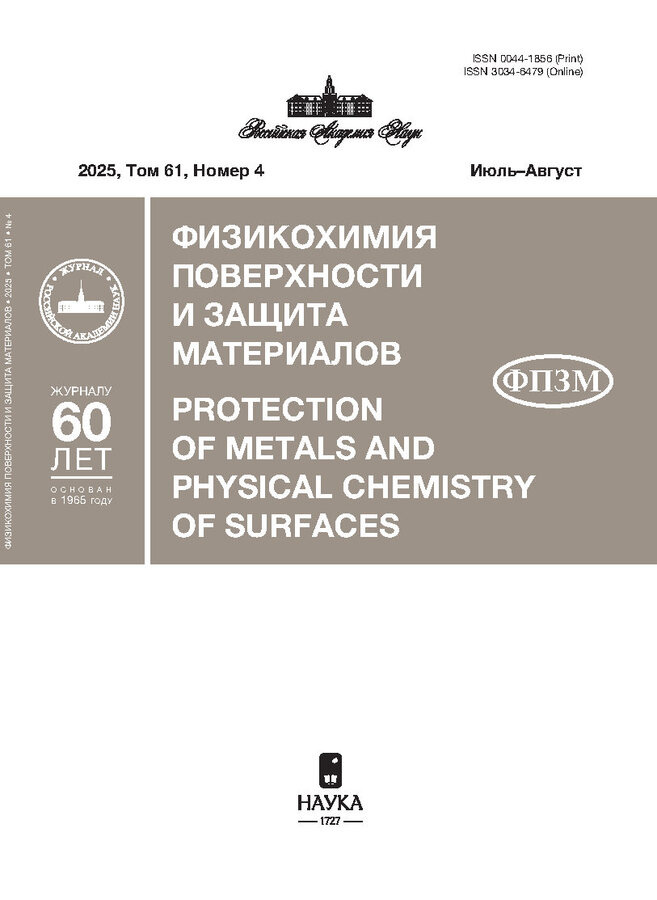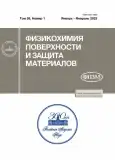Структура и свойства износостойких покрытий Ti–C–Ni–Al, полученных методом HIPIMS
- Авторы: Засыпкин М.А.1, Сытченко А.Д.1, Кирюханцев-Корнеев Ф.В.1
-
Учреждения:
- Национальный исследовательский технологический университет “МИСиС”
- Выпуск: Том 59, № 1 (2023)
- Страницы: 45-53
- Раздел: НОВЫЕ ВЕЩЕСТВА, МАТЕРИАЛЫ И ПОКРЫТИЯ
- URL: https://vestnik.nvsu.ru/0044-1856/article/view/663827
- DOI: https://doi.org/10.31857/S0044185622700048
- EDN: https://elibrary.ru/PUAKGS
- ID: 663827
Цитировать
Полный текст
Аннотация
Проведены испытания покрытий, полученных методом высокомощного импульсного магнетронного распыления (HIPIMS) c использованием мишени 64% Ti–16% C–14% Ni–6% Al (42.5 ат. % Ti, 42.5 ат. % C, 7.5 ат. % Ni, 7.5 ат. % Al). Микроструктуру и состав покрытий изучали с помощью сканирующей электронной микроскопии, оптической эмиссионной спектроскопии тлеющего разряда и рентгенофазового анализа. Покрытия были исследованы с точки зрения их твердости, модуля упругости, упругого восстановления, стойкости к упругой деформации разрушения, сопротивления пластической деформации, коэффициента трения и износостойкости при трении-скольжения, стойкости к ударно-динамическому нагружению, а также жаростойкости. Были проведены натурные испытания покрытий на режущем инструменте. Проведено сравнение свойств покрытий, полученных на постоянном токе и при высокомощном импульсном режиме. Результаты показали, что покрытия Ti–C–Ni–Al обладали плотной однородной структурой, характеризовались твердостью 12–26 ГПа, модулем упругости 143–194 ГПа, упругим восстановлением 66–90%, низким коэффициентом трения 0.24–0.4, а также высокой жаростойкостью при 800°С. Покрытие, осажденное по оптимальному режиму, подтвердило высокую практическую эффективность в ходе натурных испытаний, снизив износ режущего инструмента на ~25%.
Об авторах
М. А. Засыпкин
Национальный исследовательский технологический университет “МИСиС”
Email: alina-sytchenko@yandex.ru
Россия, 119049, Москва, Ленинский проспект, 4с1
А. Д. Сытченко
Национальный исследовательский технологический университет “МИСиС”
Email: alina-sytchenko@yandex.ru
Россия, 119049, Москва, Ленинский проспект, 4с1
Ф. В. Кирюханцев-Корнеев
Национальный исследовательский технологический университет “МИСиС”
Автор, ответственный за переписку.
Email: alina-sytchenko@yandex.ru
Россия, 119049, Москва, Ленинский проспект, 4с1
Список литературы
- Fukui H. // SEI technical review. 2016. V. 82. P. 39–45.
- Mahboobeh A., Aghdam S.R., Ahangarani A. et al. // Advanced Materials Research. 2014. M. 829. № 476.
- Chen L., Wang S.Q., Zhou S.Z. et al. // International J. Refractory Metals and Hard Materials. 2008. V. 26. P. 456–460.
- Akinribide O.J., Obadele B.A., Akinwamide S.O. et al. // Ceramics International. 2019. V. 45. P. 21077–21090.
- Xiao M., Zhang Y., Wu Y. et al. // International J. Refractory Metals and Hard Materials. 2021. V. 101. № 105672.
- Shmorgun V.G., Bogdanov A.I., Kulevich V.P. et al. // Materials Today: Proceedings. 2021. V. 38. P. 1627–1630.
- Chaliyawala H.A., Gupta G., Kumar P. et al. // Surface and Coatings Technology. 2015. V. 276. P. 431–439.
- Ma M., Sun W.-C., Zhang Y.-G. et al. // Materials Research. 2019. V. 22. № e20190530.
- Grandin M., Nedfors N., Sundberg J. et al. // Surface and Coatings Technology. 2015. V. 276. P. 210–218.
- Kiryukhantsev-Korneev Ph.V., Sheveyko A.N., Shvindina N.V. et al. // Ceramics International. 2018. V. 44. P. 7637–7646.
- Kiryukhantsev-Korneev Ph.V., Sheveyko A.N., Vorotilo S.A., Levashov E.A. // Ceramics International. 2020. V. 46. P. 1775–1783.
- Bao Y., Huang L., An Q. et al. // J. European Ceramic Society. 2020. V. 40. P. 4381–4395.
- Krysina O.V., Ivanov Yu.F., Koval N.N. et al. // Surface and Coatings Technology, 2021. V. 416. № 127153.
- Amudha A., Nagaraja H.S., Shashikala H.D. // Physica B: Condensed Matter. 2021. V. 602. № 412409.
- Bolelli G., Colella A., Lusvarghi L. et al. // Wear. 2020. V. 450–451. № 203273.
- Abegunde O., Akinlabi E., Oladijo P. // Materials Today: Proceedings. 2021. V. 44. P. 1221–1226.
- Chen Y., Wu G., He J. // Materials Science and Engineering: C. 2015. V. 48. P. 41–47.
- Singh A., Schipmann S., Mathur A. et al. // Applied Surface Science. 2017. V. 414. P. 114–123.
- Abegunde O.O., Akinlabi E.T., Oladijo O.P. // Applied Surface Science. 2020. V. 520. № 146323.
- Tudose I.V., Suchea M.P. // Functional Nanostructured Interfaces for Environmental and Biomedical Applications. 2019. P. 15–26.
- Baghriche O., Zertal A., Ehiasarian A.P. et al. // Thin Solid Films. 2012. V. 520. P. 3567–3573.
- Sytchenko A.D., Kiryukhantsev-Korneev Ph.V. // J. Phys.: Conf. Ser. 2021. V. 2064. № 012062.
- Souček P., Hnilica J., Klein P. et al. // Surface and Coatings Technology. 2021. V. 423. № 127624.
- Helmersson U., Lattemann M., Bohlmark J. et al. // Thin Solid Films. 2006. V. 513. P. 1–24.
- Kiryukhantsev-Korneev Ph.V., Sytchenko A.D., Sviridova T.A. et al. // Surface and Coatings Technology. 2022. № 128141.
- Musil J., Zeman P. // Solid State Phenomena. 2007. V. 4. P. S6–S10.
- Papa F., Gerdes H., Bandorf R. et al. // Thin Solid Films. 2011. V. 520. P. 1559–1563.
- Шевцова Л.И. Дис. к-та техн. наук: 05.16.09. НГТУ. 2015. 200 с.
- Shtansky D.V., Kiryukhantsev-Korneev Ph.V., Sheveyko A.N. et al. // Surface and Coatings Technology. 2009. V. 203. P. 3595–3609.
- André B., Lewin E., Jansson U., Wiklund U. // Wear. 2011. V. 270. P. 555–566.
- Pang X., Shi L., Wang P. et al. // Surface and Coatings Technology. 2009. V. 203. P. 1537–1543.
Дополнительные файлы



















